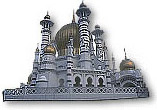| |
|
Kuala
Kangsar
 Kuala
Kangsar, located 48km north of Ipoh on the Perak River, is the royal
town of Perak. It is dominated by three beautiful buildings: Istana Iskandariah,
Istana Kenangan and the Ubudiah mosque. The Istana Iskandariah, situated
on a hill overlooking the river, is the palace of the Sultan of Perak.
Although an imposing structure, it is of less interest architecturally
than the smaller and more beautiful Istana Kenangan, which was built
as a temporary residence during the Iskandariah's construction. The Ubudiah
mosque, begun in the late nineteenth century though not completed until
after the First World War, is a magnificently picturesque structure topped
with a constellation of bright golden domes. Kuala
Kangsar, located 48km north of Ipoh on the Perak River, is the royal
town of Perak. It is dominated by three beautiful buildings: Istana Iskandariah,
Istana Kenangan and the Ubudiah mosque. The Istana Iskandariah, situated
on a hill overlooking the river, is the palace of the Sultan of Perak.
Although an imposing structure, it is of less interest architecturally
than the smaller and more beautiful Istana Kenangan, which was built
as a temporary residence during the Iskandariah's construction. The Ubudiah
mosque, begun in the late nineteenth century though not completed until
after the First World War, is a magnificently picturesque structure topped
with a constellation of bright golden domes.
Kuala Kangsar is also the home of the
Malaysian rubber industry. It was here, in 1877, that nine rubber
trees were planted by the British resident Hugh Low, marking the
arrival of an industry would within decades vie with tin as the country's
most important export.
Taiping
Taiping succeeded Kuala Kangsar as the capital of Perak in the late nineteenth
century. Taiping was during that time the thriving center of the tin industry
in the surrounding valley. In the 1890s, disused mining pools at the edge
of town were cleverly landscaped to form the beautiful Lake Gardens. The
Gardens are still tranquil and restorative, though this once bustling town
has become equally quiet. The country's oldest State Museum is within the
vicinity, containing artifacts such as ancient weapons, handicrafts and
aboriginal implements.
Bukit Larut (formerly
Maxwell Hill)
Bukit Larut, located just 10 km from Taiping, is Malaysia's oldest hill station.
Bukit Larut is not nearly as developed as the more celebrated Cameron
and Genting Highlands. However, it preserves much more of the atmosphere
of a colonial hill station, with modest, welcoming bungalows, carefully cultivated
gardens, and a pervasive atmosphere of cool quietude. The hill is accessible
by four-wheel drive only. A land rover is available at the foot of the hill.
It leaves every from 7am to 6pm. Fare: RM2.50 for adults and RM1 for children.
Lumut
85 km southwest of Ipoh is the naval base town of Lumut. Of interest here is
the Naval Museum which houses a collection of ancient weapons and historical
artifacts. Lumut is also the departure point for Perak's internationally-known islands,
Pulau Pangkor and Pulau Pangkor Laut.
River Terrapin Breeding
Project
Located at Bota Kanan, 40km from Ipoh, the project breeds hatchling river terrapins,
or Bataqur baska, which are then released into the Perak River. Between November
and March, visitors can watch river terrapins lay their eggs along the river's
shore. Chalets are available.
Ipoh
Cave Temples
The countryside around Ipoh is
studded with dramatic limestone outcroppings, many of which are dotted
with cave temples. While many of the temples are of recent origin,
cave paintings dating back two millenia have been located at one site.
The most famous of the temples are Perak Tong and Sam Poh Tong, both
built by Chinese monks who arrived in Perak with the wave of Chinese
immigrants around the turn of the century. Perak Tong is clustered
with over forty Buddha statues, the most impressive of which is almost
13 meters high. Sam Poh Tong, which continues to be inhabited by a
community of Buddhist monks and nuns, houses various statues of Buddha
among the cavern's natural stalactites and stalagmites. Perak Tong
lies 6 km north of Ipoh, and Sam Poh Tong is 5 km to the south. Both
shrines make pleasant stopover visits, and at Sam Poh Tong one can
enjoy lunch afterward at the tasty vegetarian restaurant on the temple
grounds.
Kuala
Gula Bird Sanctuary
This coastal bird sanctuary attracts a wide variety of exotic birds, particularly
during the migratory season between August and December. Hundreds of species
of birds have been sighted here, as well as a number of fascinating mammals,
the dusky leaf monkey, smooth otter, and ridge-back dolphin among them. For
information, contact the Department of Wildlife and National Parks, Ipoh.
Banding Resort
Midway along the East-West Highway is Temenggur Lake, formed by the the construction
of the magnificent Temenggur dam. Set atop an island in the lake is the
Banding Resort, a small facility offering basic accommodations and outstanding
fishing. The Bandung area is slated for tourist development in the near
future, but at the moment the Bandung Resort continues to be a lovely retreat.
Kellie's Castle
The rubber industry grew with extreme rapidity in Malaysia at the beginning
of the century, and as one would expect it attracted all sorts of fortune-seekers.
One of the most successful of these was William Kellie Smith, a Scot who
decided modestly to mark his success by constructing a magnificent castle.
As is so often and so romantically the case with such grand gestures, Kellie
died before the castle was completed. Equally to be expected is the fact
that this mysterious ruin of a half-built castle is even more lovely for
being unfinished. The castle stands enigmatically among Kellie's old lands
and is visible across the river a few miles along the road from Ipoh to
Batu Gajah. Visitors wishing to stroll around this gothic scene can take
a sampan across the river or arrange for a tour from Ipoh.
|
|
|